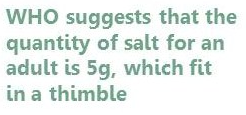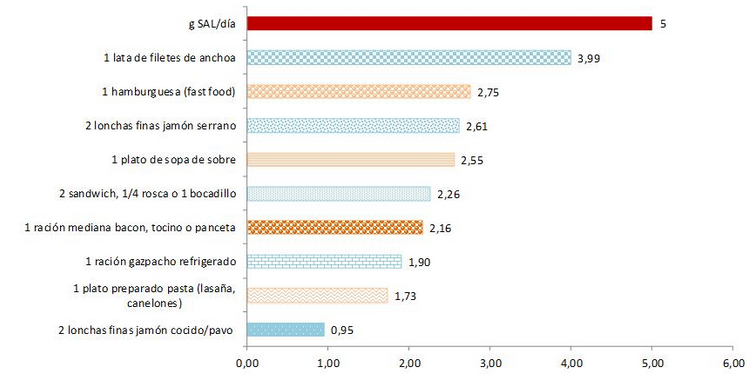‘And because I do not like dry steaks, mom, take a little sauce and flavor’. As this Spanish rumba says, in our country we use ‘salt-cellar’, in the full sense of the word. In fact, we consume 9,8 g of salt daily, which is almost twice the recommended amount. But we are not the only ones. Americans follow us closely eating an average of 8,5 g every day. World Health Organization (WHO) admits that we have a serious global problem, establishing salt reduction as a priority measure in preventing cardiovascular disease.

Each gram of common salt (sodium chloride or NaCl) provides us approximately 0,6 g of chlorine (Cl) and 0,4 g of sodium. Sodium, although is needed in small quantities, is clearly ‘the bad guy’. Sodium excess causes fluid retention (weight increase), heart problems and hypertension. WHO suggests that the quantity of salt that an adult should consume daily is 5 g, equivalent to approximately 2 g of sodium. Attention! 5 g is only a little teaspoon or a thimble.
We just have to look at the following table elaborated from the data about the salt content of a group of foods of the ‘Plan Cuidate+’, created by the Agencia Española de Seguridad Alimentaria y Nutrición (AESAN). So if we get four ham slices, we have made the day as far as salt is concerned. And if we eat it in a refrigerated sandwich, I do not think more… I just hope that WHO has calculated well because, according with them, it seems very easy to overcome the recommend intake daily. In addition, anyone dares to say to WHO something about the salt of a ham sandwich, because I imagine they would say: and who tells you to eat ham? Do not you know our recommendations about the processed meat consumption?

We are going to suppose that we try to reduce our salt consumption. In this case, it is not too easy, because the 72% of our salt consumption comes from processed food (prepared meals, fast food, snacks, cheese, cereals, etc.). This is what is known as ‘hidden salt’, and here is where manufacturers have to make an effort. In this sense, the FDA (Food and Drug Administration) in The United States of America is developing a guide in order to promote, voluntarily, the reformulation and development of new products reduced in sodium. To do this, from 2 June to 31 August, we can send them comments about sodium reduction
Little by little, our palate should get used to a less salty taste. Surely, everyone has seen that salty foods are able to modify our behavior: they are a generator of appetite and they stimulate our intake. We just have to eat pipes with salt and without salt. You can’t stop to eat the bag with salt until you finish it. (It is not an experiment with scientific rigor, but it serves to get an idea).
- Waiter! One of dung beetles! - 10 February 2023
- Attention: NutriScore Traffic Light! We have a huge mess - 14 January 2021
- Acrylamide has a special ‘COLOR’ - 23 January 2019

